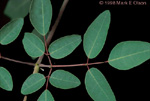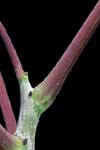



Moringa
hildebrandtii Engler
Moringa hildebrandtii
is a beautiful tree with a massive, water-storing trunk that can grow
to
20 meters tall. This bloated trunk makes Moringa hildebrandtii strongly
resemble the more well-known but unrelated baobab trees (Adansonia)
that also occur in Madagascar. The pinnately compound leaves
can be up to a meter long, and the leaf rachis and stem tip of young
plants
is often a distinctive deep red. The small whitish flowers are borne in
large sprays.
The first collection of Moringa hildebrandtii by western botanists was made in 1880, by Hildebrandt. He found it growing in the town of Trabonjy in northwestern Madagascar. Since then, other botanists have documented it growing in villages of the west coast, but no specimens have ever been collected from wild stands.
One of the main goals of
my
field work in Madagascar in early 1998 was to determine where Moringa
hildebrandtii occurs in the wild. I worked with fellow Missouri
Botanical
Garden student Sylvain Razafimandimbison. We concluded that the tree no
longer occurs in the wild. However, our assesment for the survival of
Moringa hildebrandtii is good. It is frequently planted in villages
all along the west coast of the island, and seeds abundantly. The trees
are planted as ornamentals, for medicine, and to mark special
occasions. You can download our paper here:
Inspired by our work, plantsmen searched southwestern Madagascar and in 2007 seem to have located wild stands of this species! See J. -B. Castillon and J.-P. Castillon. 2007. The recent discovery of the first wild population of Moringa hildebrandtii (Moringaceae) in Madagascar. Cactus World.




Back to the Moringa Home Page start page
home - people - research - images of the dry tropics - exploration - acknowledgements
Instituto
de Biología, Universidad Nacional Autónoma de
México
Circuito Exterior s/n, Ciudad Universitaria
Copilco, Coyoacán A. P. 70-367
C. P. 04510, México, D. F.
MÉXICO
(52)
55 5622-9124 fon (52) 55 5555-1760 fax
molson@ib.unam.mx